ECTPP102A: Critiquing Documentation and Curriculum Approaches Essay
VerifiedAdded on 2022/09/18
|13
|3585
|34
Essay
AI Summary
This essay critically examines documentation methods and curriculum approaches in early childhood education and care. It begins by defining early childhood education and its importance, along with the concept of curriculum. The essay then explores two documentation methods: jotting documentation and learning stories, detailing their characteristics and applications. Subsequently, it delves into two curriculum approaches: the Reggio Emilia curriculum approach and the child-centered curriculum approach, outlining their principles and practices. The paper then establishes the relationships between the documentation methods and curriculum approaches with behaviorist learning theory. Finally, the essay critiques the effectiveness of these documentation methods and curriculum approaches in early childhood practice, drawing on relevant literature and educational theories to support its arguments. The essay aims to provide a comprehensive understanding of the significance and application of these methods and approaches in fostering children's learning and development.
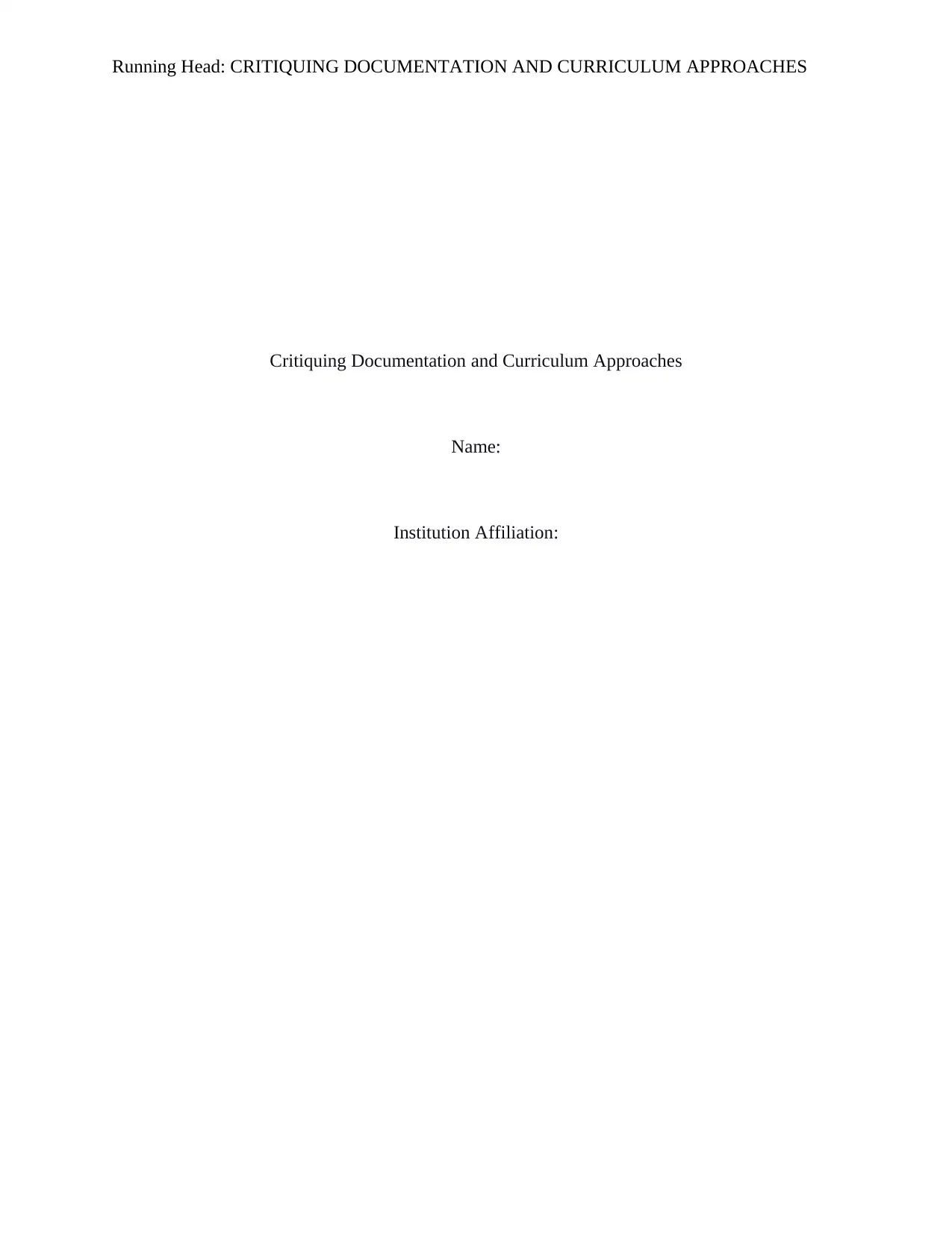
Running Head: CRITIQUING DOCUMENTATION AND CURRICULUM APPROACHES
Critiquing Documentation and Curriculum Approaches
Name:
Institution Affiliation:
Critiquing Documentation and Curriculum Approaches
Name:
Institution Affiliation:
Paraphrase This Document
Need a fresh take? Get an instant paraphrase of this document with our AI Paraphraser
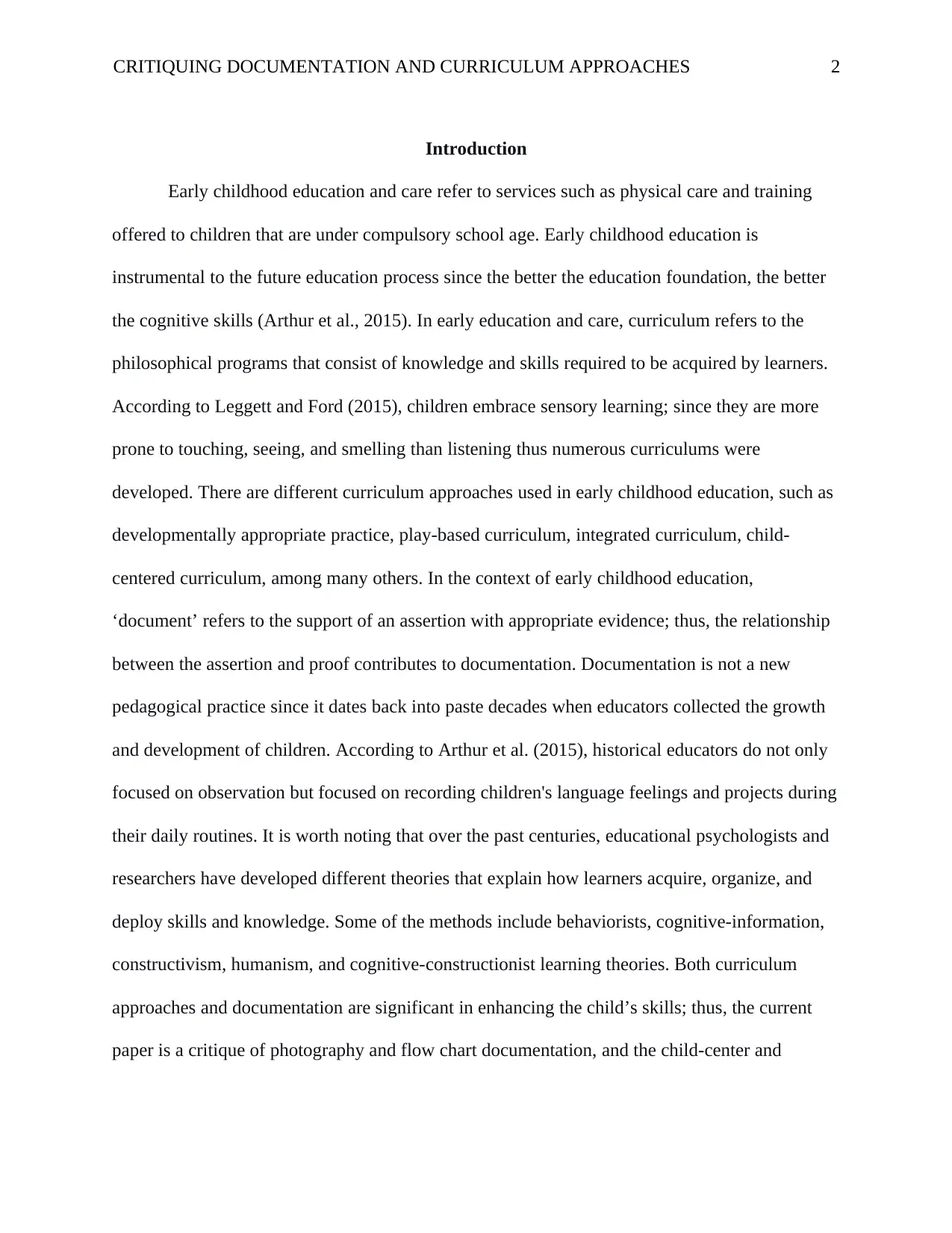
CRITIQUING DOCUMENTATION AND CURRICULUM APPROACHES 2
Introduction
Early childhood education and care refer to services such as physical care and training
offered to children that are under compulsory school age. Early childhood education is
instrumental to the future education process since the better the education foundation, the better
the cognitive skills (Arthur et al., 2015). In early education and care, curriculum refers to the
philosophical programs that consist of knowledge and skills required to be acquired by learners.
According to Leggett and Ford (2015), children embrace sensory learning; since they are more
prone to touching, seeing, and smelling than listening thus numerous curriculums were
developed. There are different curriculum approaches used in early childhood education, such as
developmentally appropriate practice, play-based curriculum, integrated curriculum, child-
centered curriculum, among many others. In the context of early childhood education,
‘document’ refers to the support of an assertion with appropriate evidence; thus, the relationship
between the assertion and proof contributes to documentation. Documentation is not a new
pedagogical practice since it dates back into paste decades when educators collected the growth
and development of children. According to Arthur et al. (2015), historical educators do not only
focused on observation but focused on recording children's language feelings and projects during
their daily routines. It is worth noting that over the past centuries, educational psychologists and
researchers have developed different theories that explain how learners acquire, organize, and
deploy skills and knowledge. Some of the methods include behaviorists, cognitive-information,
constructivism, humanism, and cognitive-constructionist learning theories. Both curriculum
approaches and documentation are significant in enhancing the child’s skills; thus, the current
paper is a critique of photography and flow chart documentation, and the child-center and
Introduction
Early childhood education and care refer to services such as physical care and training
offered to children that are under compulsory school age. Early childhood education is
instrumental to the future education process since the better the education foundation, the better
the cognitive skills (Arthur et al., 2015). In early education and care, curriculum refers to the
philosophical programs that consist of knowledge and skills required to be acquired by learners.
According to Leggett and Ford (2015), children embrace sensory learning; since they are more
prone to touching, seeing, and smelling than listening thus numerous curriculums were
developed. There are different curriculum approaches used in early childhood education, such as
developmentally appropriate practice, play-based curriculum, integrated curriculum, child-
centered curriculum, among many others. In the context of early childhood education,
‘document’ refers to the support of an assertion with appropriate evidence; thus, the relationship
between the assertion and proof contributes to documentation. Documentation is not a new
pedagogical practice since it dates back into paste decades when educators collected the growth
and development of children. According to Arthur et al. (2015), historical educators do not only
focused on observation but focused on recording children's language feelings and projects during
their daily routines. It is worth noting that over the past centuries, educational psychologists and
researchers have developed different theories that explain how learners acquire, organize, and
deploy skills and knowledge. Some of the methods include behaviorists, cognitive-information,
constructivism, humanism, and cognitive-constructionist learning theories. Both curriculum
approaches and documentation are significant in enhancing the child’s skills; thus, the current
paper is a critique of photography and flow chart documentation, and the child-center and
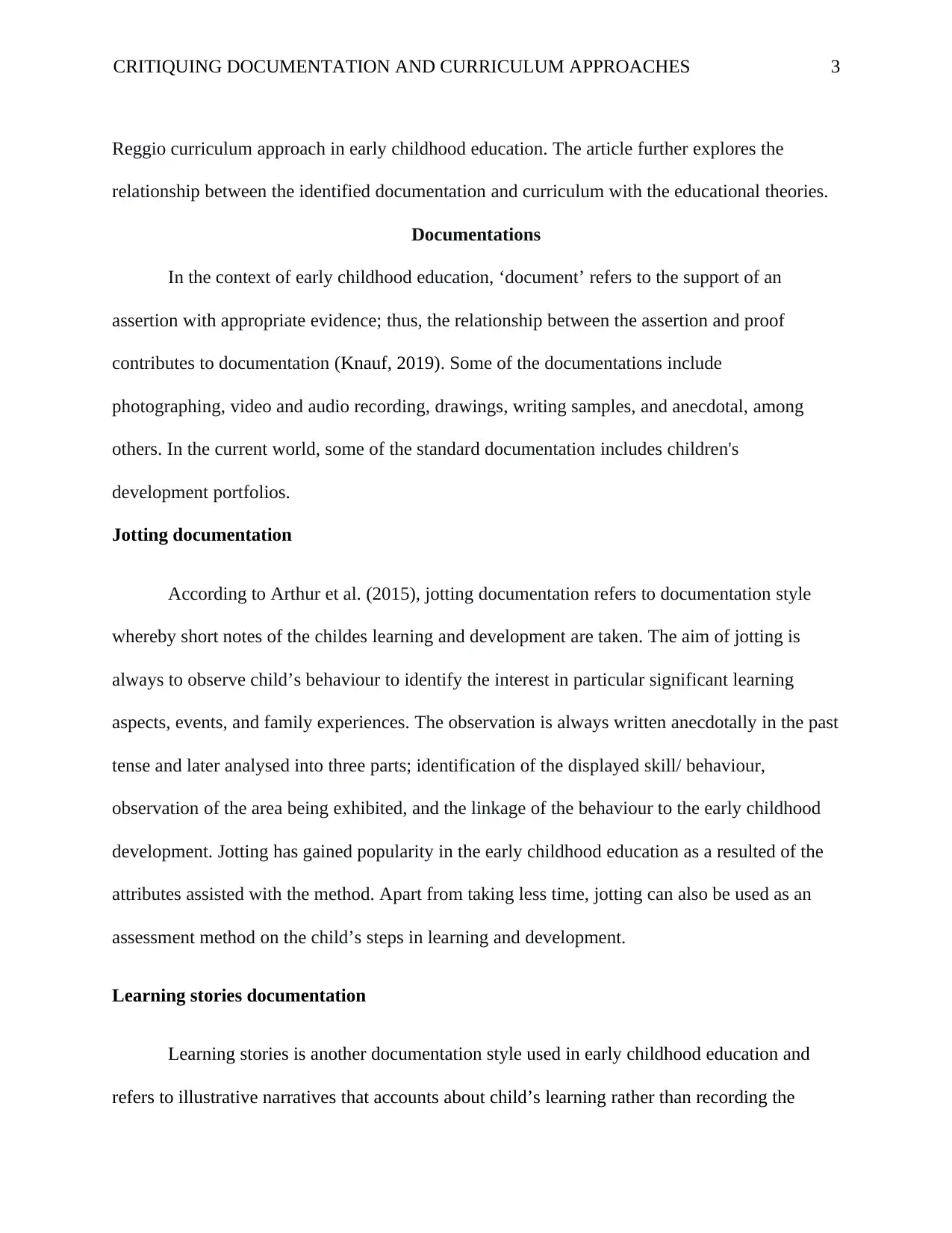
CRITIQUING DOCUMENTATION AND CURRICULUM APPROACHES 3
Reggio curriculum approach in early childhood education. The article further explores the
relationship between the identified documentation and curriculum with the educational theories.
Documentations
In the context of early childhood education, ‘document’ refers to the support of an
assertion with appropriate evidence; thus, the relationship between the assertion and proof
contributes to documentation (Knauf, 2019). Some of the documentations include
photographing, video and audio recording, drawings, writing samples, and anecdotal, among
others. In the current world, some of the standard documentation includes children's
development portfolios.
Jotting documentation
According to Arthur et al. (2015), jotting documentation refers to documentation style
whereby short notes of the childes learning and development are taken. The aim of jotting is
always to observe child’s behaviour to identify the interest in particular significant learning
aspects, events, and family experiences. The observation is always written anecdotally in the past
tense and later analysed into three parts; identification of the displayed skill/ behaviour,
observation of the area being exhibited, and the linkage of the behaviour to the early childhood
development. Jotting has gained popularity in the early childhood education as a resulted of the
attributes assisted with the method. Apart from taking less time, jotting can also be used as an
assessment method on the child’s steps in learning and development.
Learning stories documentation
Learning stories is another documentation style used in early childhood education and
refers to illustrative narratives that accounts about child’s learning rather than recording the
Reggio curriculum approach in early childhood education. The article further explores the
relationship between the identified documentation and curriculum with the educational theories.
Documentations
In the context of early childhood education, ‘document’ refers to the support of an
assertion with appropriate evidence; thus, the relationship between the assertion and proof
contributes to documentation (Knauf, 2019). Some of the documentations include
photographing, video and audio recording, drawings, writing samples, and anecdotal, among
others. In the current world, some of the standard documentation includes children's
development portfolios.
Jotting documentation
According to Arthur et al. (2015), jotting documentation refers to documentation style
whereby short notes of the childes learning and development are taken. The aim of jotting is
always to observe child’s behaviour to identify the interest in particular significant learning
aspects, events, and family experiences. The observation is always written anecdotally in the past
tense and later analysed into three parts; identification of the displayed skill/ behaviour,
observation of the area being exhibited, and the linkage of the behaviour to the early childhood
development. Jotting has gained popularity in the early childhood education as a resulted of the
attributes assisted with the method. Apart from taking less time, jotting can also be used as an
assessment method on the child’s steps in learning and development.
Learning stories documentation
Learning stories is another documentation style used in early childhood education and
refers to illustrative narratives that accounts about child’s learning rather than recording the
⊘ This is a preview!⊘
Do you want full access?
Subscribe today to unlock all pages.

Trusted by 1+ million students worldwide
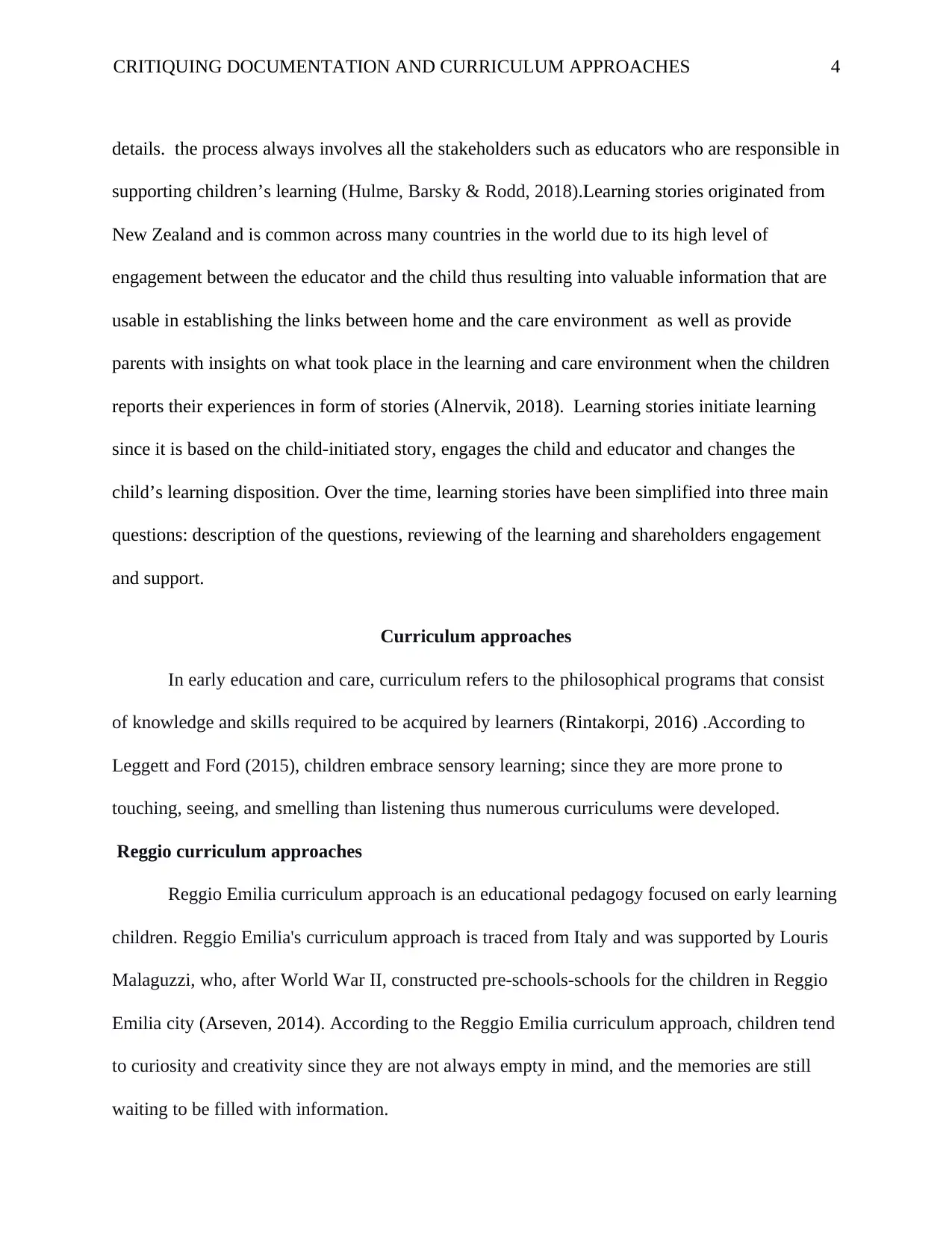
CRITIQUING DOCUMENTATION AND CURRICULUM APPROACHES 4
details. the process always involves all the stakeholders such as educators who are responsible in
supporting children’s learning (Hulme, Barsky & Rodd, 2018).Learning stories originated from
New Zealand and is common across many countries in the world due to its high level of
engagement between the educator and the child thus resulting into valuable information that are
usable in establishing the links between home and the care environment as well as provide
parents with insights on what took place in the learning and care environment when the children
reports their experiences in form of stories (Alnervik, 2018). Learning stories initiate learning
since it is based on the child-initiated story, engages the child and educator and changes the
child’s learning disposition. Over the time, learning stories have been simplified into three main
questions: description of the questions, reviewing of the learning and shareholders engagement
and support.
Curriculum approaches
In early education and care, curriculum refers to the philosophical programs that consist
of knowledge and skills required to be acquired by learners (Rintakorpi, 2016) .According to
Leggett and Ford (2015), children embrace sensory learning; since they are more prone to
touching, seeing, and smelling than listening thus numerous curriculums were developed.
Reggio curriculum approaches
Reggio Emilia curriculum approach is an educational pedagogy focused on early learning
children. Reggio Emilia's curriculum approach is traced from Italy and was supported by Louris
Malaguzzi, who, after World War II, constructed pre-schools-schools for the children in Reggio
Emilia city (Arseven, 2014). According to the Reggio Emilia curriculum approach, children tend
to curiosity and creativity since they are not always empty in mind, and the memories are still
waiting to be filled with information.
details. the process always involves all the stakeholders such as educators who are responsible in
supporting children’s learning (Hulme, Barsky & Rodd, 2018).Learning stories originated from
New Zealand and is common across many countries in the world due to its high level of
engagement between the educator and the child thus resulting into valuable information that are
usable in establishing the links between home and the care environment as well as provide
parents with insights on what took place in the learning and care environment when the children
reports their experiences in form of stories (Alnervik, 2018). Learning stories initiate learning
since it is based on the child-initiated story, engages the child and educator and changes the
child’s learning disposition. Over the time, learning stories have been simplified into three main
questions: description of the questions, reviewing of the learning and shareholders engagement
and support.
Curriculum approaches
In early education and care, curriculum refers to the philosophical programs that consist
of knowledge and skills required to be acquired by learners (Rintakorpi, 2016) .According to
Leggett and Ford (2015), children embrace sensory learning; since they are more prone to
touching, seeing, and smelling than listening thus numerous curriculums were developed.
Reggio curriculum approaches
Reggio Emilia curriculum approach is an educational pedagogy focused on early learning
children. Reggio Emilia's curriculum approach is traced from Italy and was supported by Louris
Malaguzzi, who, after World War II, constructed pre-schools-schools for the children in Reggio
Emilia city (Arseven, 2014). According to the Reggio Emilia curriculum approach, children tend
to curiosity and creativity since they are not always empty in mind, and the memories are still
waiting to be filled with information.
Paraphrase This Document
Need a fresh take? Get an instant paraphrase of this document with our AI Paraphraser
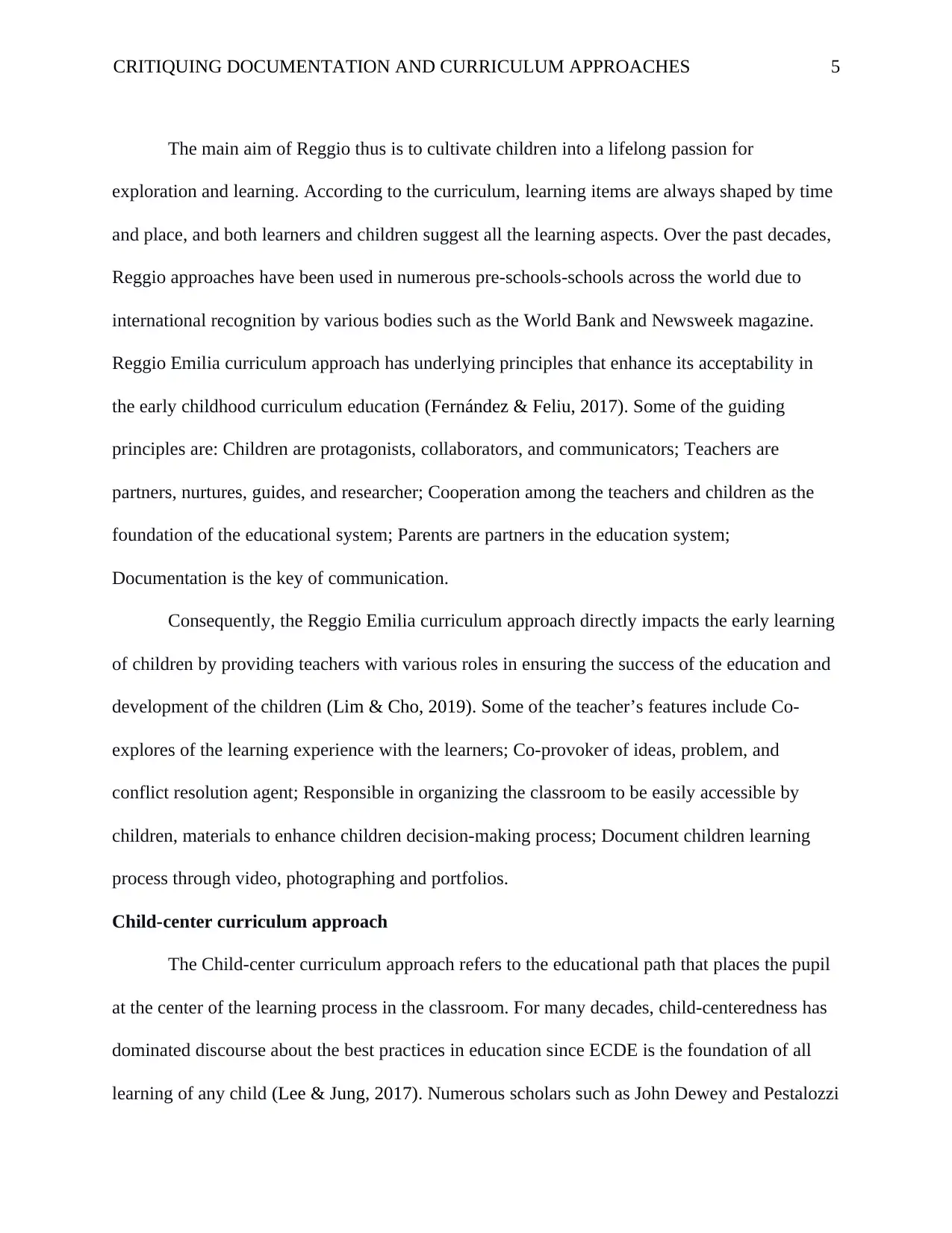
CRITIQUING DOCUMENTATION AND CURRICULUM APPROACHES 5
The main aim of Reggio thus is to cultivate children into a lifelong passion for
exploration and learning. According to the curriculum, learning items are always shaped by time
and place, and both learners and children suggest all the learning aspects. Over the past decades,
Reggio approaches have been used in numerous pre-schools-schools across the world due to
international recognition by various bodies such as the World Bank and Newsweek magazine.
Reggio Emilia curriculum approach has underlying principles that enhance its acceptability in
the early childhood curriculum education (Fernández & Feliu, 2017). Some of the guiding
principles are: Children are protagonists, collaborators, and communicators; Teachers are
partners, nurtures, guides, and researcher; Cooperation among the teachers and children as the
foundation of the educational system; Parents are partners in the education system;
Documentation is the key of communication.
Consequently, the Reggio Emilia curriculum approach directly impacts the early learning
of children by providing teachers with various roles in ensuring the success of the education and
development of the children (Lim & Cho, 2019). Some of the teacher’s features include Co-
explores of the learning experience with the learners; Co-provoker of ideas, problem, and
conflict resolution agent; Responsible in organizing the classroom to be easily accessible by
children, materials to enhance children decision-making process; Document children learning
process through video, photographing and portfolios.
Child-center curriculum approach
The Child-center curriculum approach refers to the educational path that places the pupil
at the center of the learning process in the classroom. For many decades, child-centeredness has
dominated discourse about the best practices in education since ECDE is the foundation of all
learning of any child (Lee & Jung, 2017). Numerous scholars such as John Dewey and Pestalozzi
The main aim of Reggio thus is to cultivate children into a lifelong passion for
exploration and learning. According to the curriculum, learning items are always shaped by time
and place, and both learners and children suggest all the learning aspects. Over the past decades,
Reggio approaches have been used in numerous pre-schools-schools across the world due to
international recognition by various bodies such as the World Bank and Newsweek magazine.
Reggio Emilia curriculum approach has underlying principles that enhance its acceptability in
the early childhood curriculum education (Fernández & Feliu, 2017). Some of the guiding
principles are: Children are protagonists, collaborators, and communicators; Teachers are
partners, nurtures, guides, and researcher; Cooperation among the teachers and children as the
foundation of the educational system; Parents are partners in the education system;
Documentation is the key of communication.
Consequently, the Reggio Emilia curriculum approach directly impacts the early learning
of children by providing teachers with various roles in ensuring the success of the education and
development of the children (Lim & Cho, 2019). Some of the teacher’s features include Co-
explores of the learning experience with the learners; Co-provoker of ideas, problem, and
conflict resolution agent; Responsible in organizing the classroom to be easily accessible by
children, materials to enhance children decision-making process; Document children learning
process through video, photographing and portfolios.
Child-center curriculum approach
The Child-center curriculum approach refers to the educational path that places the pupil
at the center of the learning process in the classroom. For many decades, child-centeredness has
dominated discourse about the best practices in education since ECDE is the foundation of all
learning of any child (Lee & Jung, 2017). Numerous scholars such as John Dewey and Pestalozzi
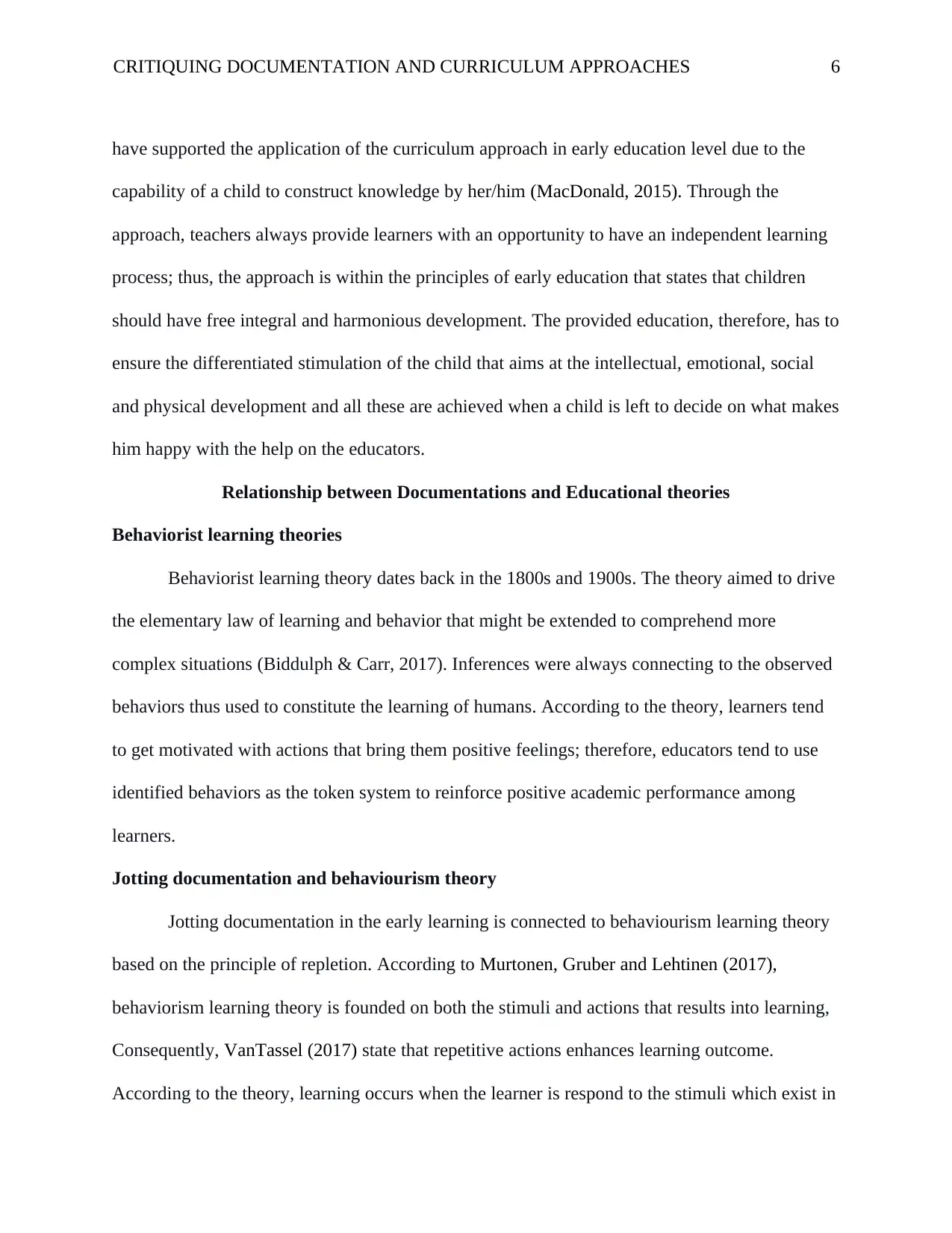
CRITIQUING DOCUMENTATION AND CURRICULUM APPROACHES 6
have supported the application of the curriculum approach in early education level due to the
capability of a child to construct knowledge by her/him (MacDonald, 2015). Through the
approach, teachers always provide learners with an opportunity to have an independent learning
process; thus, the approach is within the principles of early education that states that children
should have free integral and harmonious development. The provided education, therefore, has to
ensure the differentiated stimulation of the child that aims at the intellectual, emotional, social
and physical development and all these are achieved when a child is left to decide on what makes
him happy with the help on the educators.
Relationship between Documentations and Educational theories
Behaviorist learning theories
Behaviorist learning theory dates back in the 1800s and 1900s. The theory aimed to drive
the elementary law of learning and behavior that might be extended to comprehend more
complex situations (Biddulph & Carr, 2017). Inferences were always connecting to the observed
behaviors thus used to constitute the learning of humans. According to the theory, learners tend
to get motivated with actions that bring them positive feelings; therefore, educators tend to use
identified behaviors as the token system to reinforce positive academic performance among
learners.
Jotting documentation and behaviourism theory
Jotting documentation in the early learning is connected to behaviourism learning theory
based on the principle of repletion. According to Murtonen, Gruber and Lehtinen (2017),
behaviorism learning theory is founded on both the stimuli and actions that results into learning,
Consequently, VanTassel (2017) state that repetitive actions enhances learning outcome.
According to the theory, learning occurs when the learner is respond to the stimuli which exist in
have supported the application of the curriculum approach in early education level due to the
capability of a child to construct knowledge by her/him (MacDonald, 2015). Through the
approach, teachers always provide learners with an opportunity to have an independent learning
process; thus, the approach is within the principles of early education that states that children
should have free integral and harmonious development. The provided education, therefore, has to
ensure the differentiated stimulation of the child that aims at the intellectual, emotional, social
and physical development and all these are achieved when a child is left to decide on what makes
him happy with the help on the educators.
Relationship between Documentations and Educational theories
Behaviorist learning theories
Behaviorist learning theory dates back in the 1800s and 1900s. The theory aimed to drive
the elementary law of learning and behavior that might be extended to comprehend more
complex situations (Biddulph & Carr, 2017). Inferences were always connecting to the observed
behaviors thus used to constitute the learning of humans. According to the theory, learners tend
to get motivated with actions that bring them positive feelings; therefore, educators tend to use
identified behaviors as the token system to reinforce positive academic performance among
learners.
Jotting documentation and behaviourism theory
Jotting documentation in the early learning is connected to behaviourism learning theory
based on the principle of repletion. According to Murtonen, Gruber and Lehtinen (2017),
behaviorism learning theory is founded on both the stimuli and actions that results into learning,
Consequently, VanTassel (2017) state that repetitive actions enhances learning outcome.
According to the theory, learning occurs when the learner is respond to the stimuli which exist in
⊘ This is a preview!⊘
Do you want full access?
Subscribe today to unlock all pages.

Trusted by 1+ million students worldwide
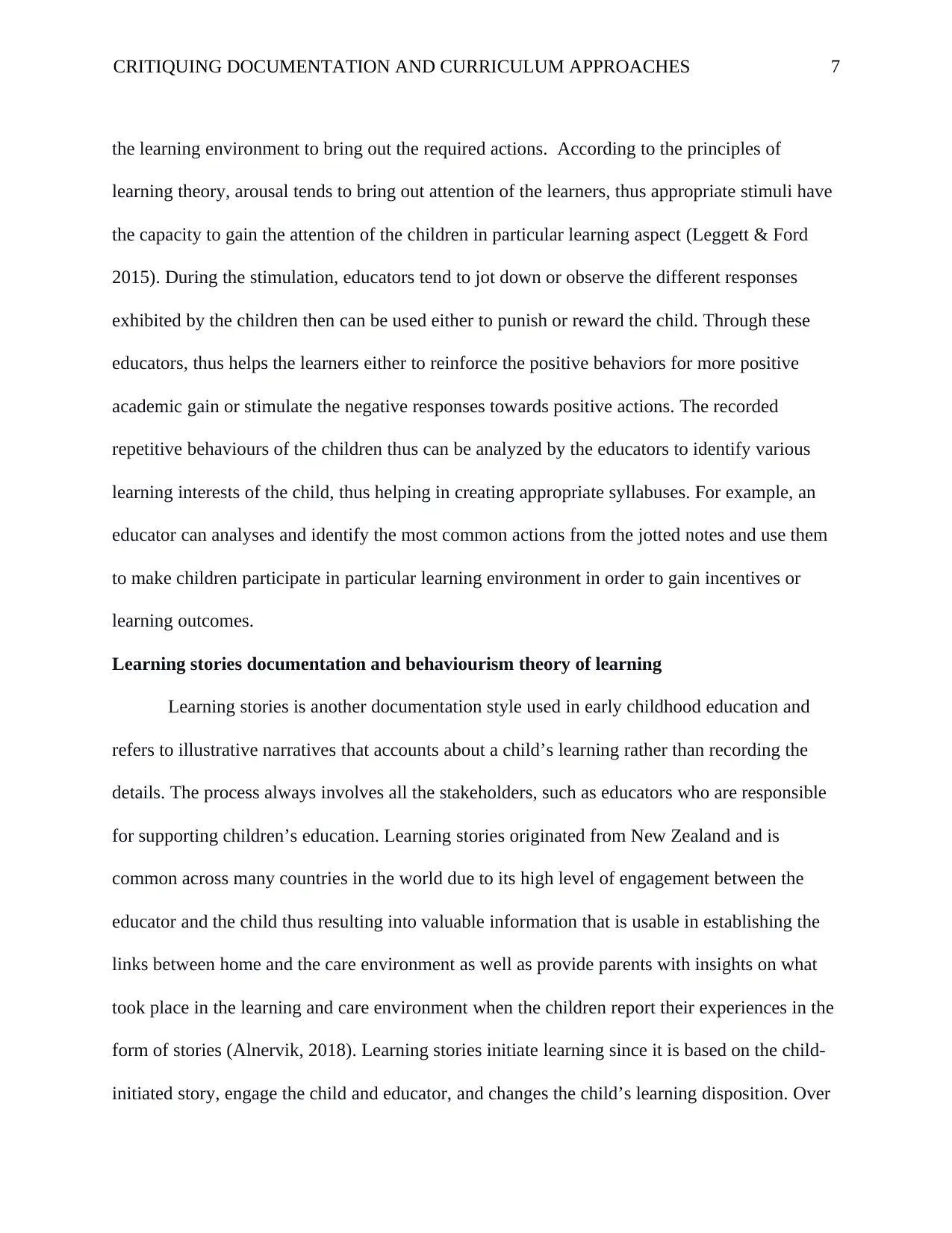
CRITIQUING DOCUMENTATION AND CURRICULUM APPROACHES 7
the learning environment to bring out the required actions. According to the principles of
learning theory, arousal tends to bring out attention of the learners, thus appropriate stimuli have
the capacity to gain the attention of the children in particular learning aspect (Leggett & Ford
2015). During the stimulation, educators tend to jot down or observe the different responses
exhibited by the children then can be used either to punish or reward the child. Through these
educators, thus helps the learners either to reinforce the positive behaviors for more positive
academic gain or stimulate the negative responses towards positive actions. The recorded
repetitive behaviours of the children thus can be analyzed by the educators to identify various
learning interests of the child, thus helping in creating appropriate syllabuses. For example, an
educator can analyses and identify the most common actions from the jotted notes and use them
to make children participate in particular learning environment in order to gain incentives or
learning outcomes.
Learning stories documentation and behaviourism theory of learning
Learning stories is another documentation style used in early childhood education and
refers to illustrative narratives that accounts about a child’s learning rather than recording the
details. The process always involves all the stakeholders, such as educators who are responsible
for supporting children’s education. Learning stories originated from New Zealand and is
common across many countries in the world due to its high level of engagement between the
educator and the child thus resulting into valuable information that is usable in establishing the
links between home and the care environment as well as provide parents with insights on what
took place in the learning and care environment when the children report their experiences in the
form of stories (Alnervik, 2018). Learning stories initiate learning since it is based on the child-
initiated story, engage the child and educator, and changes the child’s learning disposition. Over
the learning environment to bring out the required actions. According to the principles of
learning theory, arousal tends to bring out attention of the learners, thus appropriate stimuli have
the capacity to gain the attention of the children in particular learning aspect (Leggett & Ford
2015). During the stimulation, educators tend to jot down or observe the different responses
exhibited by the children then can be used either to punish or reward the child. Through these
educators, thus helps the learners either to reinforce the positive behaviors for more positive
academic gain or stimulate the negative responses towards positive actions. The recorded
repetitive behaviours of the children thus can be analyzed by the educators to identify various
learning interests of the child, thus helping in creating appropriate syllabuses. For example, an
educator can analyses and identify the most common actions from the jotted notes and use them
to make children participate in particular learning environment in order to gain incentives or
learning outcomes.
Learning stories documentation and behaviourism theory of learning
Learning stories is another documentation style used in early childhood education and
refers to illustrative narratives that accounts about a child’s learning rather than recording the
details. The process always involves all the stakeholders, such as educators who are responsible
for supporting children’s education. Learning stories originated from New Zealand and is
common across many countries in the world due to its high level of engagement between the
educator and the child thus resulting into valuable information that is usable in establishing the
links between home and the care environment as well as provide parents with insights on what
took place in the learning and care environment when the children report their experiences in the
form of stories (Alnervik, 2018). Learning stories initiate learning since it is based on the child-
initiated story, engage the child and educator, and changes the child’s learning disposition. Over
Paraphrase This Document
Need a fresh take? Get an instant paraphrase of this document with our AI Paraphraser
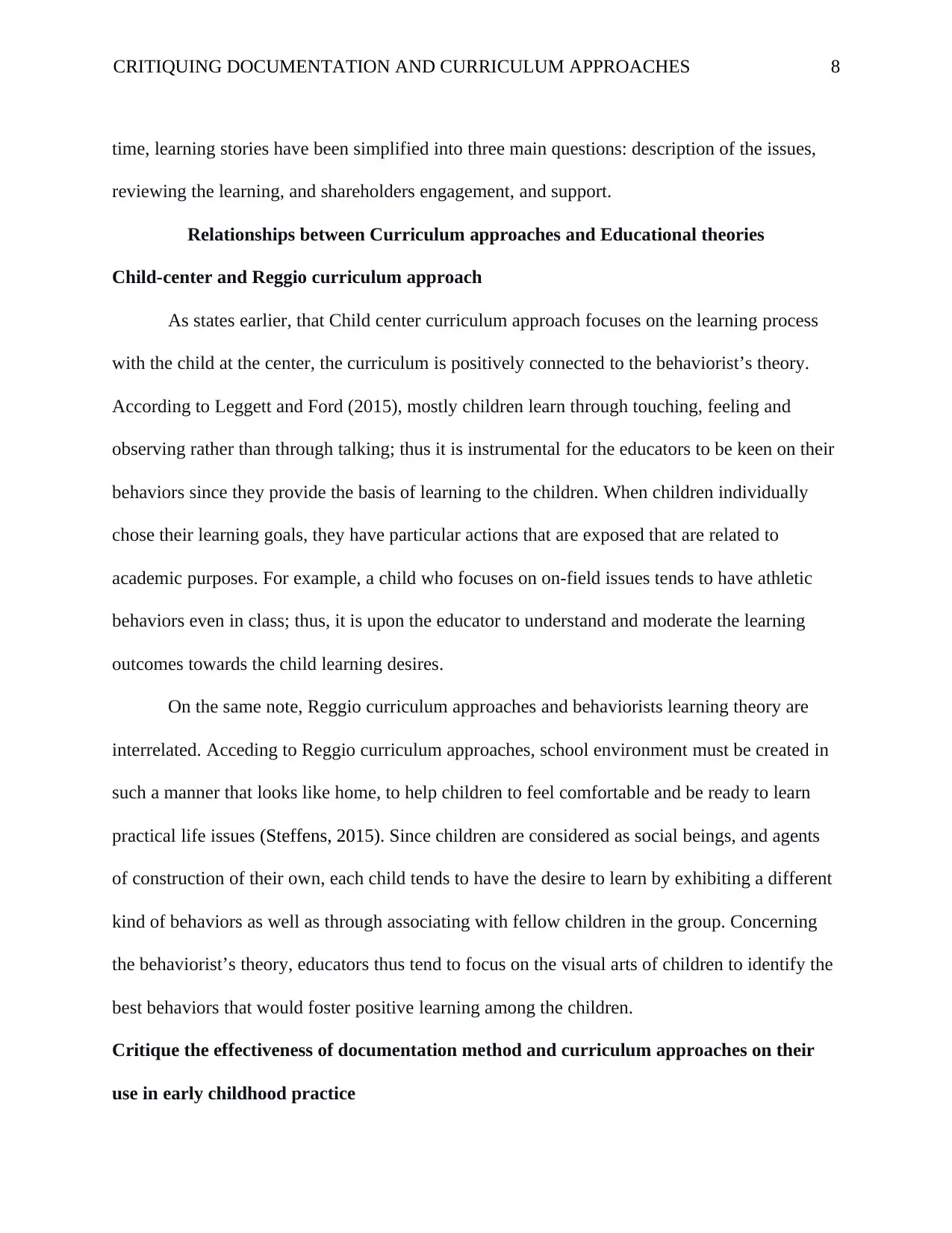
CRITIQUING DOCUMENTATION AND CURRICULUM APPROACHES 8
time, learning stories have been simplified into three main questions: description of the issues,
reviewing the learning, and shareholders engagement, and support.
Relationships between Curriculum approaches and Educational theories
Child-center and Reggio curriculum approach
As states earlier, that Child center curriculum approach focuses on the learning process
with the child at the center, the curriculum is positively connected to the behaviorist’s theory.
According to Leggett and Ford (2015), mostly children learn through touching, feeling and
observing rather than through talking; thus it is instrumental for the educators to be keen on their
behaviors since they provide the basis of learning to the children. When children individually
chose their learning goals, they have particular actions that are exposed that are related to
academic purposes. For example, a child who focuses on on-field issues tends to have athletic
behaviors even in class; thus, it is upon the educator to understand and moderate the learning
outcomes towards the child learning desires.
On the same note, Reggio curriculum approaches and behaviorists learning theory are
interrelated. Acceding to Reggio curriculum approaches, school environment must be created in
such a manner that looks like home, to help children to feel comfortable and be ready to learn
practical life issues (Steffens, 2015). Since children are considered as social beings, and agents
of construction of their own, each child tends to have the desire to learn by exhibiting a different
kind of behaviors as well as through associating with fellow children in the group. Concerning
the behaviorist’s theory, educators thus tend to focus on the visual arts of children to identify the
best behaviors that would foster positive learning among the children.
Critique the effectiveness of documentation method and curriculum approaches on their
use in early childhood practice
time, learning stories have been simplified into three main questions: description of the issues,
reviewing the learning, and shareholders engagement, and support.
Relationships between Curriculum approaches and Educational theories
Child-center and Reggio curriculum approach
As states earlier, that Child center curriculum approach focuses on the learning process
with the child at the center, the curriculum is positively connected to the behaviorist’s theory.
According to Leggett and Ford (2015), mostly children learn through touching, feeling and
observing rather than through talking; thus it is instrumental for the educators to be keen on their
behaviors since they provide the basis of learning to the children. When children individually
chose their learning goals, they have particular actions that are exposed that are related to
academic purposes. For example, a child who focuses on on-field issues tends to have athletic
behaviors even in class; thus, it is upon the educator to understand and moderate the learning
outcomes towards the child learning desires.
On the same note, Reggio curriculum approaches and behaviorists learning theory are
interrelated. Acceding to Reggio curriculum approaches, school environment must be created in
such a manner that looks like home, to help children to feel comfortable and be ready to learn
practical life issues (Steffens, 2015). Since children are considered as social beings, and agents
of construction of their own, each child tends to have the desire to learn by exhibiting a different
kind of behaviors as well as through associating with fellow children in the group. Concerning
the behaviorist’s theory, educators thus tend to focus on the visual arts of children to identify the
best behaviors that would foster positive learning among the children.
Critique the effectiveness of documentation method and curriculum approaches on their
use in early childhood practice
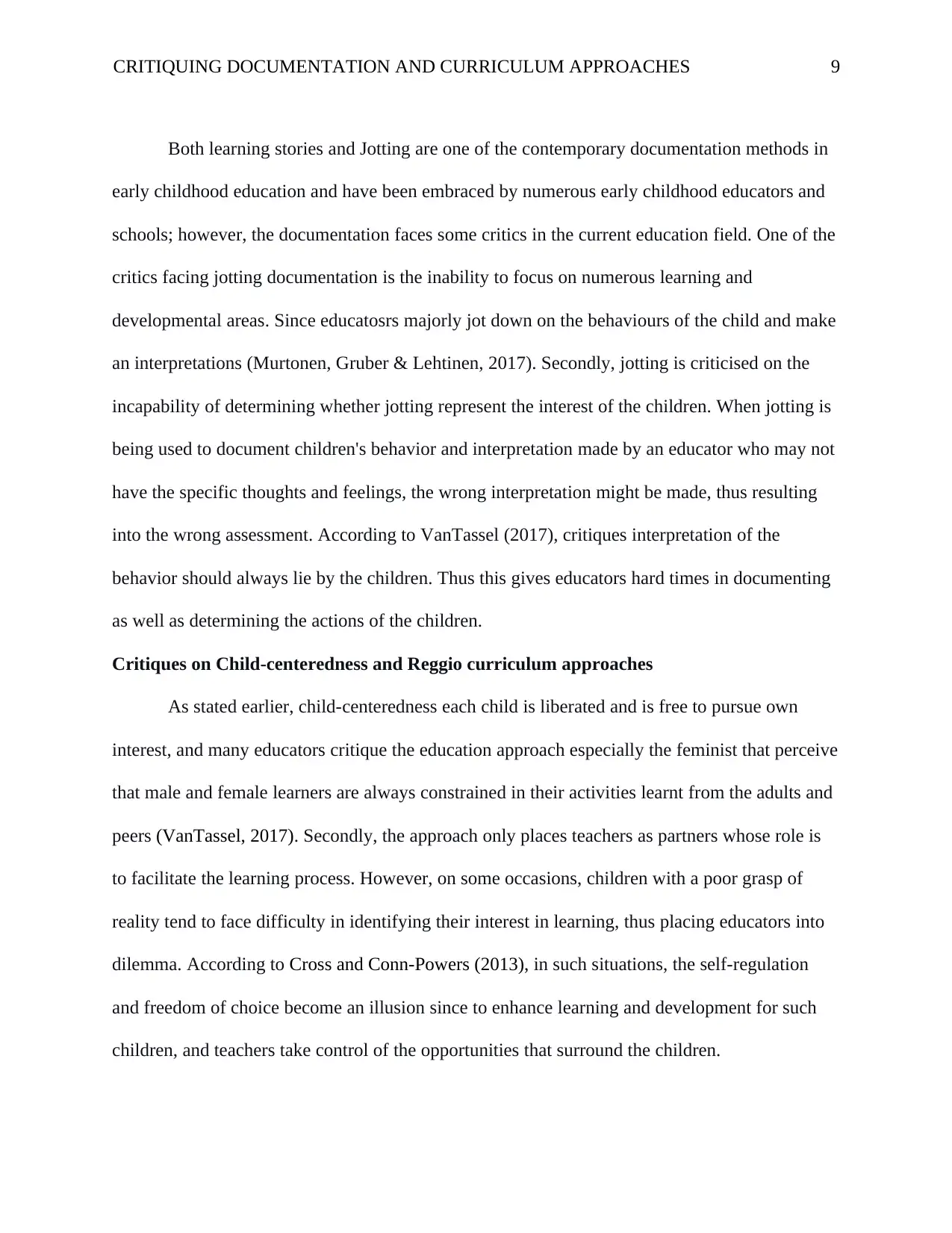
CRITIQUING DOCUMENTATION AND CURRICULUM APPROACHES 9
Both learning stories and Jotting are one of the contemporary documentation methods in
early childhood education and have been embraced by numerous early childhood educators and
schools; however, the documentation faces some critics in the current education field. One of the
critics facing jotting documentation is the inability to focus on numerous learning and
developmental areas. Since educatosrs majorly jot down on the behaviours of the child and make
an interpretations (Murtonen, Gruber & Lehtinen, 2017). Secondly, jotting is criticised on the
incapability of determining whether jotting represent the interest of the children. When jotting is
being used to document children's behavior and interpretation made by an educator who may not
have the specific thoughts and feelings, the wrong interpretation might be made, thus resulting
into the wrong assessment. According to VanTassel (2017), critiques interpretation of the
behavior should always lie by the children. Thus this gives educators hard times in documenting
as well as determining the actions of the children.
Critiques on Child-centeredness and Reggio curriculum approaches
As stated earlier, child-centeredness each child is liberated and is free to pursue own
interest, and many educators critique the education approach especially the feminist that perceive
that male and female learners are always constrained in their activities learnt from the adults and
peers (VanTassel, 2017). Secondly, the approach only places teachers as partners whose role is
to facilitate the learning process. However, on some occasions, children with a poor grasp of
reality tend to face difficulty in identifying their interest in learning, thus placing educators into
dilemma. According to Cross and Conn-Powers (2013), in such situations, the self-regulation
and freedom of choice become an illusion since to enhance learning and development for such
children, and teachers take control of the opportunities that surround the children.
Both learning stories and Jotting are one of the contemporary documentation methods in
early childhood education and have been embraced by numerous early childhood educators and
schools; however, the documentation faces some critics in the current education field. One of the
critics facing jotting documentation is the inability to focus on numerous learning and
developmental areas. Since educatosrs majorly jot down on the behaviours of the child and make
an interpretations (Murtonen, Gruber & Lehtinen, 2017). Secondly, jotting is criticised on the
incapability of determining whether jotting represent the interest of the children. When jotting is
being used to document children's behavior and interpretation made by an educator who may not
have the specific thoughts and feelings, the wrong interpretation might be made, thus resulting
into the wrong assessment. According to VanTassel (2017), critiques interpretation of the
behavior should always lie by the children. Thus this gives educators hard times in documenting
as well as determining the actions of the children.
Critiques on Child-centeredness and Reggio curriculum approaches
As stated earlier, child-centeredness each child is liberated and is free to pursue own
interest, and many educators critique the education approach especially the feminist that perceive
that male and female learners are always constrained in their activities learnt from the adults and
peers (VanTassel, 2017). Secondly, the approach only places teachers as partners whose role is
to facilitate the learning process. However, on some occasions, children with a poor grasp of
reality tend to face difficulty in identifying their interest in learning, thus placing educators into
dilemma. According to Cross and Conn-Powers (2013), in such situations, the self-regulation
and freedom of choice become an illusion since to enhance learning and development for such
children, and teachers take control of the opportunities that surround the children.
⊘ This is a preview!⊘
Do you want full access?
Subscribe today to unlock all pages.

Trusted by 1+ million students worldwide
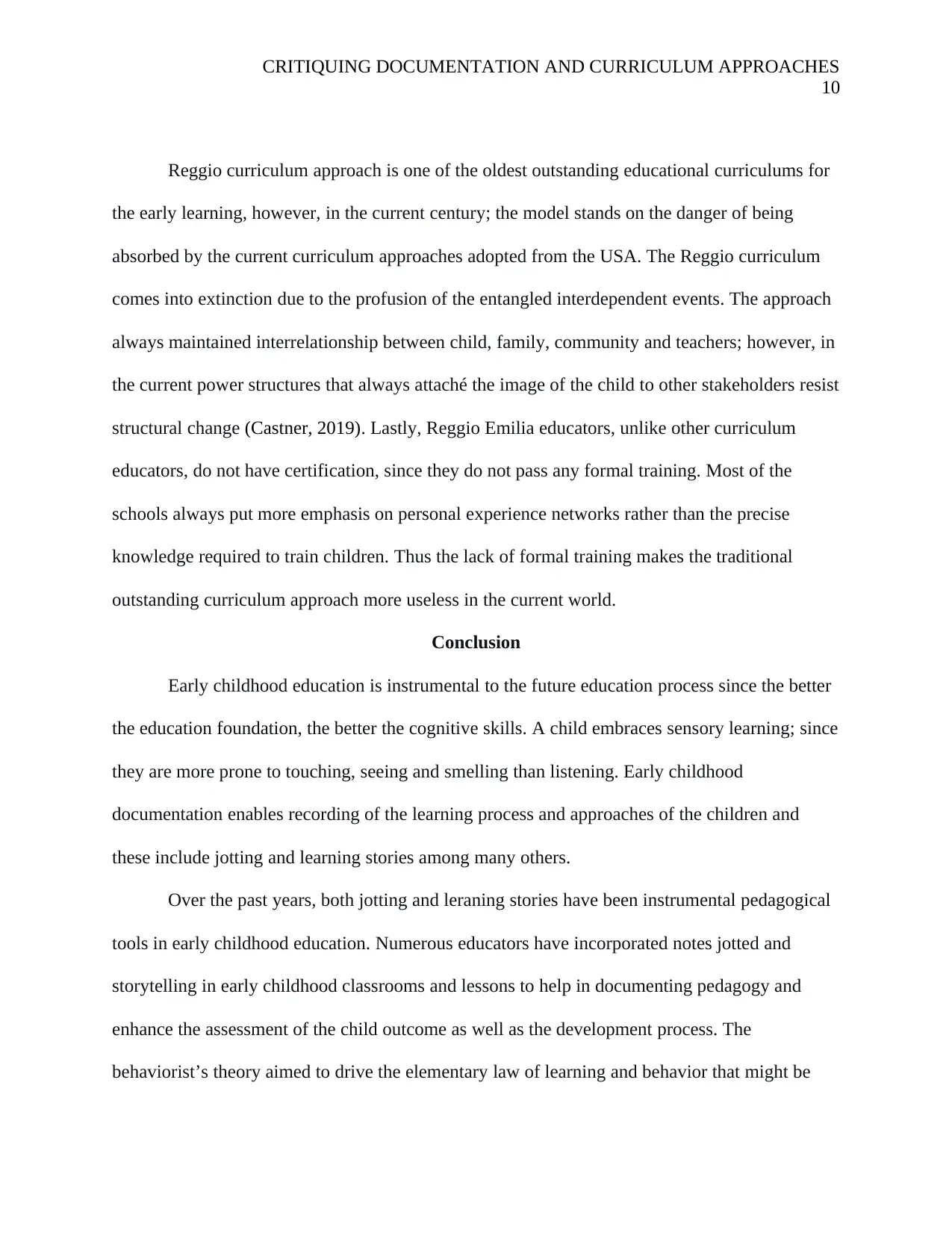
CRITIQUING DOCUMENTATION AND CURRICULUM APPROACHES
10
Reggio curriculum approach is one of the oldest outstanding educational curriculums for
the early learning, however, in the current century; the model stands on the danger of being
absorbed by the current curriculum approaches adopted from the USA. The Reggio curriculum
comes into extinction due to the profusion of the entangled interdependent events. The approach
always maintained interrelationship between child, family, community and teachers; however, in
the current power structures that always attaché the image of the child to other stakeholders resist
structural change (Castner, 2019). Lastly, Reggio Emilia educators, unlike other curriculum
educators, do not have certification, since they do not pass any formal training. Most of the
schools always put more emphasis on personal experience networks rather than the precise
knowledge required to train children. Thus the lack of formal training makes the traditional
outstanding curriculum approach more useless in the current world.
Conclusion
Early childhood education is instrumental to the future education process since the better
the education foundation, the better the cognitive skills. A child embraces sensory learning; since
they are more prone to touching, seeing and smelling than listening. Early childhood
documentation enables recording of the learning process and approaches of the children and
these include jotting and learning stories among many others.
Over the past years, both jotting and leraning stories have been instrumental pedagogical
tools in early childhood education. Numerous educators have incorporated notes jotted and
storytelling in early childhood classrooms and lessons to help in documenting pedagogy and
enhance the assessment of the child outcome as well as the development process. The
behaviorist’s theory aimed to drive the elementary law of learning and behavior that might be
10
Reggio curriculum approach is one of the oldest outstanding educational curriculums for
the early learning, however, in the current century; the model stands on the danger of being
absorbed by the current curriculum approaches adopted from the USA. The Reggio curriculum
comes into extinction due to the profusion of the entangled interdependent events. The approach
always maintained interrelationship between child, family, community and teachers; however, in
the current power structures that always attaché the image of the child to other stakeholders resist
structural change (Castner, 2019). Lastly, Reggio Emilia educators, unlike other curriculum
educators, do not have certification, since they do not pass any formal training. Most of the
schools always put more emphasis on personal experience networks rather than the precise
knowledge required to train children. Thus the lack of formal training makes the traditional
outstanding curriculum approach more useless in the current world.
Conclusion
Early childhood education is instrumental to the future education process since the better
the education foundation, the better the cognitive skills. A child embraces sensory learning; since
they are more prone to touching, seeing and smelling than listening. Early childhood
documentation enables recording of the learning process and approaches of the children and
these include jotting and learning stories among many others.
Over the past years, both jotting and leraning stories have been instrumental pedagogical
tools in early childhood education. Numerous educators have incorporated notes jotted and
storytelling in early childhood classrooms and lessons to help in documenting pedagogy and
enhance the assessment of the child outcome as well as the development process. The
behaviorist’s theory aimed to drive the elementary law of learning and behavior that might be
Paraphrase This Document
Need a fresh take? Get an instant paraphrase of this document with our AI Paraphraser
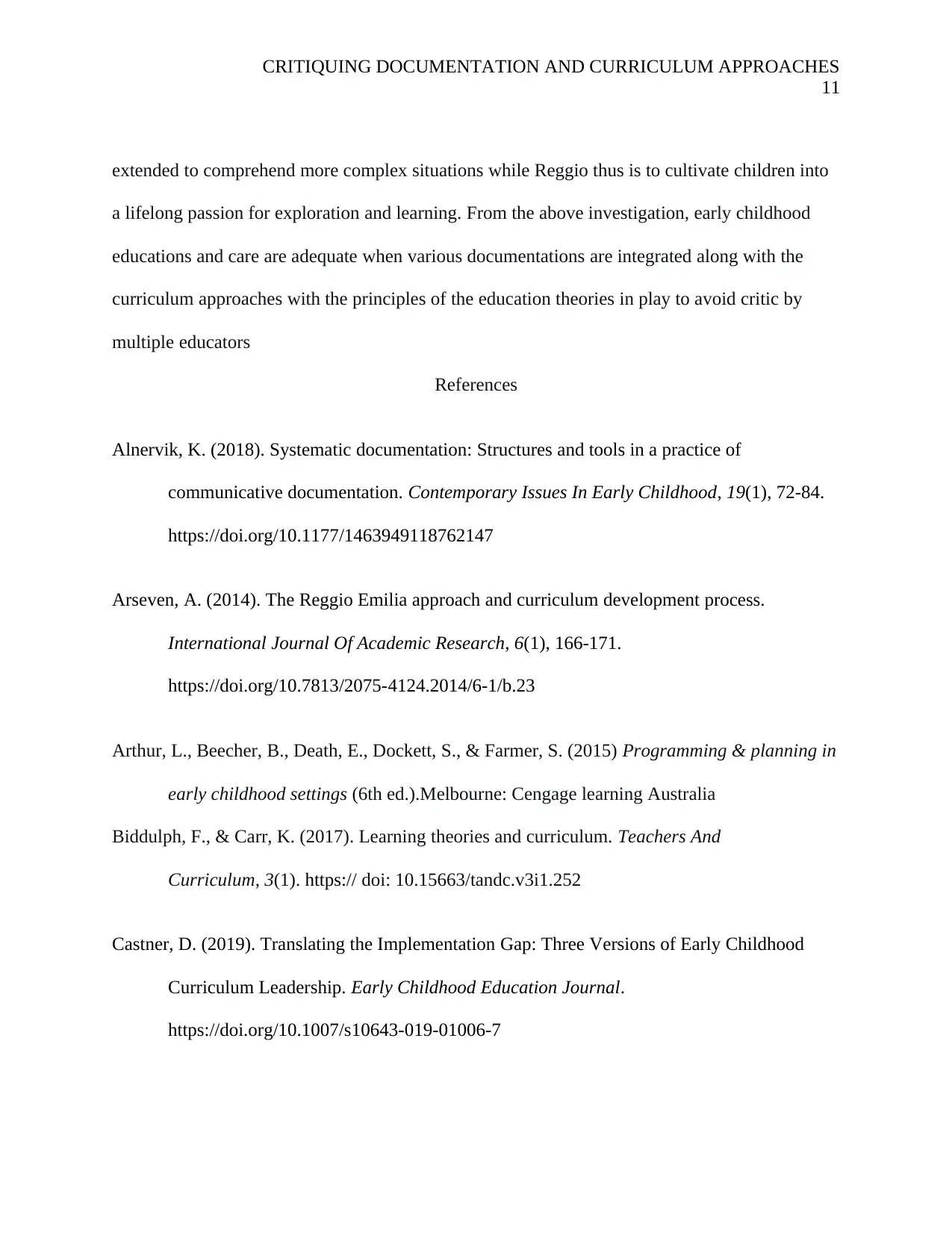
CRITIQUING DOCUMENTATION AND CURRICULUM APPROACHES
11
extended to comprehend more complex situations while Reggio thus is to cultivate children into
a lifelong passion for exploration and learning. From the above investigation, early childhood
educations and care are adequate when various documentations are integrated along with the
curriculum approaches with the principles of the education theories in play to avoid critic by
multiple educators
References
Alnervik, K. (2018). Systematic documentation: Structures and tools in a practice of
communicative documentation. Contemporary Issues In Early Childhood, 19(1), 72-84.
https://doi.org/10.1177/1463949118762147
Arseven, A. (2014). The Reggio Emilia approach and curriculum development process.
International Journal Of Academic Research, 6(1), 166-171.
https://doi.org/10.7813/2075-4124.2014/6-1/b.23
Arthur, L., Beecher, B., Death, E., Dockett, S., & Farmer, S. (2015) Programming & planning in
early childhood settings (6th ed.).Melbourne: Cengage learning Australia
Biddulph, F., & Carr, K. (2017). Learning theories and curriculum. Teachers And
Curriculum, 3(1). https:// doi: 10.15663/tandc.v3i1.252
Castner, D. (2019). Translating the Implementation Gap: Three Versions of Early Childhood
Curriculum Leadership. Early Childhood Education Journal.
https://doi.org/10.1007/s10643-019-01006-7
11
extended to comprehend more complex situations while Reggio thus is to cultivate children into
a lifelong passion for exploration and learning. From the above investigation, early childhood
educations and care are adequate when various documentations are integrated along with the
curriculum approaches with the principles of the education theories in play to avoid critic by
multiple educators
References
Alnervik, K. (2018). Systematic documentation: Structures and tools in a practice of
communicative documentation. Contemporary Issues In Early Childhood, 19(1), 72-84.
https://doi.org/10.1177/1463949118762147
Arseven, A. (2014). The Reggio Emilia approach and curriculum development process.
International Journal Of Academic Research, 6(1), 166-171.
https://doi.org/10.7813/2075-4124.2014/6-1/b.23
Arthur, L., Beecher, B., Death, E., Dockett, S., & Farmer, S. (2015) Programming & planning in
early childhood settings (6th ed.).Melbourne: Cengage learning Australia
Biddulph, F., & Carr, K. (2017). Learning theories and curriculum. Teachers And
Curriculum, 3(1). https:// doi: 10.15663/tandc.v3i1.252
Castner, D. (2019). Translating the Implementation Gap: Three Versions of Early Childhood
Curriculum Leadership. Early Childhood Education Journal.
https://doi.org/10.1007/s10643-019-01006-7
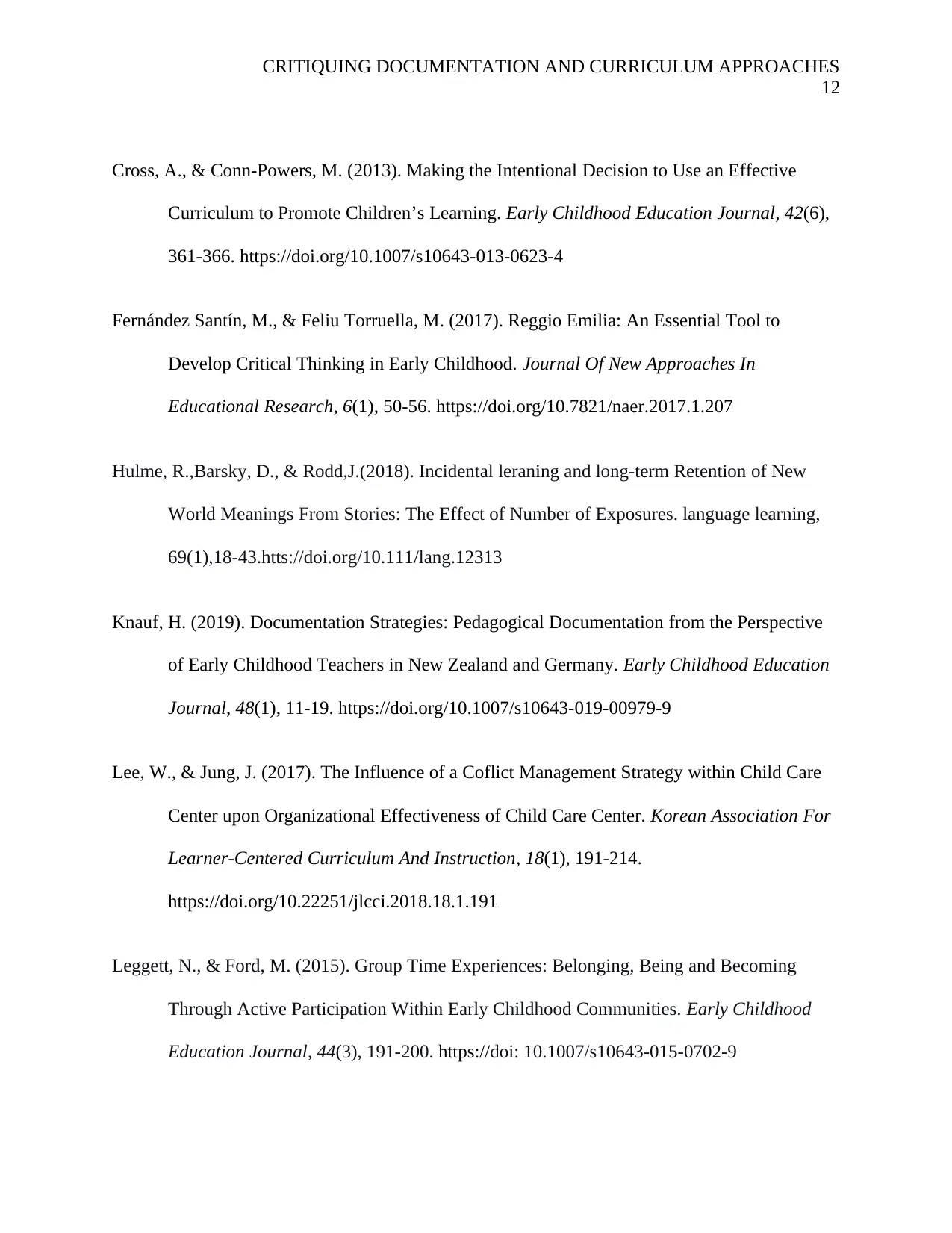
CRITIQUING DOCUMENTATION AND CURRICULUM APPROACHES
12
Cross, A., & Conn-Powers, M. (2013). Making the Intentional Decision to Use an Effective
Curriculum to Promote Children’s Learning. Early Childhood Education Journal, 42(6),
361-366. https://doi.org/10.1007/s10643-013-0623-4
Fernández Santín, M., & Feliu Torruella, M. (2017). Reggio Emilia: An Essential Tool to
Develop Critical Thinking in Early Childhood. Journal Of New Approaches In
Educational Research, 6(1), 50-56. https://doi.org/10.7821/naer.2017.1.207
Hulme, R.,Barsky, D., & Rodd,J.(2018). Incidental leraning and long-term Retention of New
World Meanings From Stories: The Effect of Number of Exposures. language learning,
69(1),18-43.htts://doi.org/10.111/lang.12313
Knauf, H. (2019). Documentation Strategies: Pedagogical Documentation from the Perspective
of Early Childhood Teachers in New Zealand and Germany. Early Childhood Education
Journal, 48(1), 11-19. https://doi.org/10.1007/s10643-019-00979-9
Lee, W., & Jung, J. (2017). The Influence of a Coflict Management Strategy within Child Care
Center upon Organizational Effectiveness of Child Care Center. Korean Association For
Learner-Centered Curriculum And Instruction, 18(1), 191-214.
https://doi.org/10.22251/jlcci.2018.18.1.191
Leggett, N., & Ford, M. (2015). Group Time Experiences: Belonging, Being and Becoming
Through Active Participation Within Early Childhood Communities. Early Childhood
Education Journal, 44(3), 191-200. https://doi: 10.1007/s10643-015-0702-9
12
Cross, A., & Conn-Powers, M. (2013). Making the Intentional Decision to Use an Effective
Curriculum to Promote Children’s Learning. Early Childhood Education Journal, 42(6),
361-366. https://doi.org/10.1007/s10643-013-0623-4
Fernández Santín, M., & Feliu Torruella, M. (2017). Reggio Emilia: An Essential Tool to
Develop Critical Thinking in Early Childhood. Journal Of New Approaches In
Educational Research, 6(1), 50-56. https://doi.org/10.7821/naer.2017.1.207
Hulme, R.,Barsky, D., & Rodd,J.(2018). Incidental leraning and long-term Retention of New
World Meanings From Stories: The Effect of Number of Exposures. language learning,
69(1),18-43.htts://doi.org/10.111/lang.12313
Knauf, H. (2019). Documentation Strategies: Pedagogical Documentation from the Perspective
of Early Childhood Teachers in New Zealand and Germany. Early Childhood Education
Journal, 48(1), 11-19. https://doi.org/10.1007/s10643-019-00979-9
Lee, W., & Jung, J. (2017). The Influence of a Coflict Management Strategy within Child Care
Center upon Organizational Effectiveness of Child Care Center. Korean Association For
Learner-Centered Curriculum And Instruction, 18(1), 191-214.
https://doi.org/10.22251/jlcci.2018.18.1.191
Leggett, N., & Ford, M. (2015). Group Time Experiences: Belonging, Being and Becoming
Through Active Participation Within Early Childhood Communities. Early Childhood
Education Journal, 44(3), 191-200. https://doi: 10.1007/s10643-015-0702-9
⊘ This is a preview!⊘
Do you want full access?
Subscribe today to unlock all pages.

Trusted by 1+ million students worldwide
1 out of 13
Related Documents
Your All-in-One AI-Powered Toolkit for Academic Success.
+13062052269
info@desklib.com
Available 24*7 on WhatsApp / Email
![[object Object]](/_next/static/media/star-bottom.7253800d.svg)
Unlock your academic potential
Copyright © 2020–2025 A2Z Services. All Rights Reserved. Developed and managed by ZUCOL.





